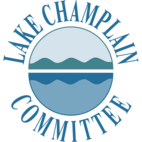Goldeneye
January 2013

While winter’s cold drives many birds away from our region, it also brings different species here. A day spent walking along the shores of Lake Champlain may reward you with rafts of hardy ducks at the edge of the ice. Perhaps the most frequently encountered of the winter diving ducks is the common goldeneye. They are somewhat small compact balls of feathers and they often form large rafts on the lake. They are also known as whistlers because of the sound the wind makes when streaking through their feathers.
As winter’s days lengthen you can start to watch the courtship of the goldeneye. The whole ritual is as complex as wooing in a Jane Austen novel and involves as many as 14 distinct behaviors, often with four males displaying for every female. Males throw their heads back, kick at the water, and call to the female. Interested females respond back with some of the same behaviors. Once the female has made a choice, the male will guard her from the advances of other males.
While a few common goldeneye breed as far south as Lake Champlain, most of our ducks nest in the northern forests of Canada. The species as a whole ranges through Russia and Scandinavia as well. Courtship continues through the spring even after the ducks leave Lake Champlain for their breeding grounds. The female selects a nest hole during the summer before heading to the wintering grounds. That means the male must follow her back home. Often, other males will follow as well and the chosen mate must remain vigilant to ensure he’s not displaced.
Goldeneye nest in tree cavities carved out by large woodpeckers. They are generally located near water, but may be a mile or two away. A female chooses a nest sites close to where she hatched, and she will return to the same cavity year after year. Nests consist of little more than some down from the female’s breast feathers and whatever debris has fallen into the cavity.
Parental care in goldeneye is minimal. The male stays with the female as she lays seven to ten eggs, guarding her from other males throughout. However, once the female has completed egg laying, the male abandons her. Females guard the young, but do not feed them. She will leave the brood as soon as the young can fly. Only about one-third of young survive that long.
Not all goldeneye bother building nests. In areas where cavities are scarce, a female who was unable to find one for herself simply lays her eggs in someone else’s nest. The fact that females return to their natal land means she may be imposing upon a sister to raise her young. Goldeneye can not distinguish the extra eggs as not belonging to them. They do adjust the number of eggs they lay, depositing fewer when parasitized, so the brood size does not get too large.
Common goldeneye along with Barrow’s goldeneye and bufflehead comprise the genus Bucephala which means ox-headed. All three species are small, cavity nesting, diving ducks of the northern woods. The specific name of common goldeneye, clangula, means noisy and refers to the whistling of the wings of birds in flight.
Both Barrow’s goldeneye and bufflehead can also be found on Lake Champlain, with bufflehead being much more common. Bufflehead are quite distinct from goldeneye. In addition to being smaller, the back of the male’s head is all white. In contrast, the goldeneye has only a small white spot in the front of the face. The Barrow’s goldeneye, a more western species, appears very similar to the common. The best distinguishing features are the low flat head shape on Barrow’s (compared to tall and peaked on common) and, in females a shorter, mostly yellow bill (compared to mostly black on common).
As spring nears most of our goldeneye will be winging their way north. Winter is the time to enjoy watching their displays on Lake Champlain. So dress warm, grab some binoculars and find the ice edge or a stretch of open water. It is likely some goldeneye will be waiting there for you.
Lake Look is a monthly natural history column produced by the Lake Champlain Committee (LCC). Formed in 1963, LCC is the only bi-state organization solely dedicated to protecting Lake Champlain’s health and accessibility. LCC uses science-based advocacy, education, and collaborative action to protect and restore water quality, safeguard natural habitats, foster stewardship, and ensure recreational access.
Get involved by joining LCC using our website secure form (at www.lakechamplaincommittee.org), or mail your contribution (Lake Champlain Committee, 208 Flynn Avenue - BLDG 3 - STUDIO 3-F, Burlington, VT 05401), or contact us at (802) 658-1414, or lcc@lakechamplaincommittee.org for more information.
